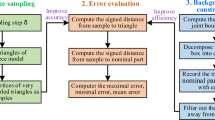Abstract
Presented in this paper is an algorithm to compute machining volumes from a rough part model by comparing it with the corresponding final part model. In regard to the comparison, the most intuitive idea is to use a 3D BOOLEANING operation, but it is not desirable because of heavy computation costs and potential degeneracy cases. To cope with the difficulties, we transformed the machining volume computation problem into a simpler one by using the inherent attributes of the problem. The transforming procedure consists of two steps: 1) transforming the machining volume computation problem into a 2D BOOLEANING problem on the 2D domain of a parent surface, and 2) transforming the 2D BOOLEANING problem into a 1D BOOLEANING problem on the 1D domain of a parent curve. Since the proposed algorithm is based on a 1D BOOLEANING operation instead of a 3D BOOLEANING operation, it is very efficient and robust.
Similar content being viewed by others
Reference
Choi BK, Barash MM (1985) STOPP: an approach to CADCAM integration. Comput Aided Des 17(4):162–168
Park SC (2003) Knowledge capturing methodology in process planning. Comput Aided Des 35(12):1109–1117
Ramesh M, Belludi N, Yip-Hoi D, Dutta D, Wascher P (2002) Application of feature technology to modeling and dimensioning the intermediate geometry of automotive powertrain components. Proceedings seventh ACM symposium on solid modeling and applications, Saarbrucken, Germany pp 313–320
Kailash SB, Zhang YF, Fuh JYH (2001) A volume decomposition approach to machining feature extraction of casting and forging components. Comput Aided Des 33(8):605–617
Kim YS, Wang E (2002) Recognition of machining features for cast then machined parts. Comput Aided Des 34(1):71–87
Vandenbrande JH, Requicha AAG (1993) Spatial reasoning for the automatic recognition of machinable features in solid models. IEEE Transactions Pattern Analysis & Machine Intelligence 15(12):1269–1285
Joshi S, Chang TC (1988) Graph-based heuristics for recognition of machined features from a 3D solid model. Comput Aided Des 20(2):58–66
Gayankar P, Henderson MR (1990) Graph-based extraction of protrusions and depressions from boundary representations. Comput Aided Des 22(7):442–450
Woo TC (1982) Feature extraction by volume decomposition. Proceedings of the Conference on CAD/CAM Technology in Mechanical Engineering 76–94
Dong J, Vijayan S (1997) Manufacturing feature decomposition and extraction-Part I: optimal volume segment. Comput Aided Des 29(6):427–440
Dong J, Vijayan S (1997) Manufacturing feature decomposition and extraction- Part II: a heuristic approach. Comput Aided Des 29(7):475–484
Vatii BR (1992) A generic solution to polygon clipping. Commun ACM 35(7):56–63
Ham I, Lu SCY (1998) Computer-aided process planning: the present and the future. Ann CIRP 37(2):591–601
Kang TS, Nnaji BO (2002) Feature representation and classification for automatic process planning systems. J Manuf Syst 12(2):133–145
Salomons OW, Houten FJAM, Kals HJJ (2002) Review of research in feature-based design. J Manuf Syst 12(2):113–132
Alting L, Zhang H (1989) Computer-aided process planning: the state-of-the-art survey. Int J Prod Res 27(4):553–585
Wang E (1992) Using automatic feature recognition to interface CAD to CAPP. Comput Eng 1:215–231
Pratt MJ (1993) Application of feature recognition in the product life-cycle. Comput Integrated Manuf 6(1–2):13–19
Author information
Authors and Affiliations
Corresponding author
Rights and permissions
About this article
Cite this article
Chang, M., Park, S.C. An algorithm to extract machining volumes. Int J Adv Manuf Technol 36, 942–949 (2008). https://doi.org/10.1007/s00170-006-0912-9
Received:
Accepted:
Published:
Issue Date:
DOI: https://doi.org/10.1007/s00170-006-0912-9



